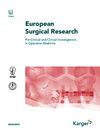Laser speckle contrast imaging for intraoperative assessment of intestinal microcirculation in normo- and hypovolemic circulation in a porcine model
IF 1.9
4区 医学
Q2 SURGERY
引用次数: 0
Abstract
Introduction: Healing is essential for successful colorectal surgery. Optimal microcirculation is needed to ensure this; however, this is only subjectively assessed by the surgeon. Laser Speckle Contrast Imaging (LSCI) is an objective non-contact, image-based method to quantify microcirculation in bowel ends. This study aimed to evaluate the application of LSCI in an open surgery porcine model, determine differences between normal and impaired microcirculation, and test the LSCI applicability to repeated measurements. Method: A midline laparotomy was made in ten healthy female pigs to expose the colon and small intestine. Subsequently, baseline measurements were conducted. A local arteria supplying the colonic or small intestine mesentery was clamped for 5 min. and LSCI measures were made again. After an hour’s rest, LSCI measurements were done in two unaffected areas on the colon and the small intestine, and baseline values were recorded. Hypotension was induced with rapid bleeding and LSCI measurements were done. After the mean arterial blood pressure (MAP) dropped to 50-60 mmHg, norepinephrine infusion was started. At a stable MAP of 85-100 mmHg, LSCI measurements were repeated at 0 min. and 30 min. during continuous norepinephrine infusion. Results: Cross-clamping caused LSCI levels to drop equally in both the colon and small intestine by 60% in the entire the clamped zone. Compared to baseline, the microcirculation measured by LSCI in the unclamped adjacent transition zone was diminished by 33% and 40%, colon and small intestines, respectively. During hypotension due to bleeding, LSCI decreased as expected. When MAP was stabilized by norepinephrine infusion, LSCI values dropped further: compared to baseline, measurements decreased with 24% and 20% in colon and small intestines, respectively. Conclusion: LSCI can be used as a quantitative, real-time, non-contact method to detect changes in the microcirculation during open intestinal surgery with large changes in microcirculation due to e.g., hypovolemic and norepinephrine infusion. It is simple to use and in contrast to the existing intraoperative microcirculation assessment techniques, LSCI stands out primarily for its elimination of the requirement for a dye. As our study has shown, this feature allows us to perform time-independent measurements and repeat them indefinitely in nearby regions without compromising the effectiveness of the method.激光斑点对比成像术中评估猪模型正常和低血容量循环中的肠道微循环
引言:愈合是成功结肠直肠手术的关键。为了确保这一点,需要最佳的微循环;然而,这只能由外科医生主观评估。激光散斑对比成像(LSCI)是一种客观的、非接触的、基于图像的方法来量化肠道末端的微循环。本研究旨在评估LSCI在开放手术猪模型中的应用,确定正常微循环和受损微循环的差异,并测试LSCI在重复测量中的适用性。方法:对10头健康母猪进行中线剖腹探查,显露结肠和小肠。随后进行基线测量。夹持结肠或小肠肠系膜局部动脉5分钟,再次行LSCI测量。休息一小时后,在结肠和小肠两个未受影响的区域进行LSCI测量,并记录基线值。快速出血诱导低血压,并进行LSCI测量。平均动脉血压(MAP)降至50-60 mmHg后,开始输注去甲肾上腺素。在稳定的MAP为85-100 mmHg时,在持续输注去甲肾上腺素的0分钟和30分钟重复LSCI测量。结果:交叉夹紧使结肠和小肠LSCI水平在整个夹紧区平均下降60%。与基线相比,LSCI测量的未夹紧邻近过渡区结肠和小肠的微循环分别减少了33%和40%。在因出血引起的低血压期间,LSCI如预期的那样下降。当MAP通过去甲肾上腺素输注稳定后,LSCI值进一步下降:与基线相比,结肠和小肠的测量值分别下降了24%和20%。结论:LSCI可作为一种定量、实时、非接触的方法,检测开放肠手术中由于低血容量、去甲肾上腺素输注等引起的微循环变化。它使用简单,与现有的术中微循环评估技术相比,LSCI的突出之处在于它不需要染料。正如我们的研究所表明的那样,这一特性使我们能够进行与时间无关的测量,并在附近区域无限地重复测量,而不会影响方法的有效性。
本文章由计算机程序翻译,如有差异,请以英文原文为准。
求助全文
约1分钟内获得全文
求助全文
来源期刊
CiteScore
2.30
自引率
6.20%
发文量
31
审稿时长
>12 weeks
期刊介绍:
''European Surgical Research'' features original clinical and experimental papers, condensed reviews of new knowledge relevant to surgical research, and short technical notes serving the information needs of investigators in various fields of operative medicine. Coverage includes surgery, surgical pathophysiology, drug usage, and new surgical techniques. Special consideration is given to information on the use of animal models, physiological and biological methods as well as biophysical measuring and recording systems. The journal is of particular value for workers interested in pathophysiologic concepts, new techniques and in how these can be introduced into clinical work or applied when critical decisions are made concerning the use of new procedures or drugs.

 求助内容:
求助内容: 应助结果提醒方式:
应助结果提醒方式:


